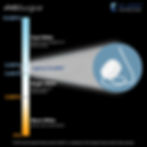
1. Colour Temperature
What is Colour Temperature?
Colour Temperature is the measurement of a light source’s colour relative to an ideal light source. The unit of measurement for colour temperature is Kelvin, measured on a scale from 1,000 to 10,000. Daylight colour temperature is around 5,800 K, and the International Electrotechnical Commission (IEC) requires the colour temperature of surgical lights to be within the 3,000 – 6,700 K range. These colours provide the surgeon with the truest tissue colour rendition.
Cool colours in reducing eye fatigue
Colours over 5,000 K are higher on the Kelvin scale and are known as ‘cool’ colours, whilst colours of a lower value on the same scale are called ‘warm’ colours. The higher value light gives the appearance of blue-ish white. For longer surgeries, a 5,000 K light might also be preferred to reduce eye fatigue.
Bright, white, LED light
For many years, halogen bulbs were used in surgical theatres because they give off a higher level of whiteness than incandescent or conventional lights. However, halogen bulbs are still inherently yellow, with typical colour temperatures around 3,200 K. Manufactures used to attempt at removing the yellow light using expensive coatings and filters, which managed to raise the colour temperature to a more palatable level of around 4400 K. Although this process attempted to turn halogen lighting whiter, the colour was still not desirable for optimal operation theatre procedures. In addition, the coatings and filters used were difficult to apply, hence the colour variability between light heads were high. LEDs, on the other hand, can be engineered to produce white light at the preferred colour temperature and no filters or reflective coatings are required to “correct” their colour.
In fact, one of the most notable features of a high-quality LED surgical light is how white its colour is. This is because it is critical to maintain optimal colour temperature during surgery for surgeons to distinguish different tones of body tissues, flesh colours and fluids. If the light were to have tones of other colours, it can be misleading, and change the appearance of the patient’s tissues. Being able to see the flesh tone clearly is vitally important to their work and patient safety.
2. Colour Rendition

What is Colour Rendition?
The Colour Rendering Index (CRI) is measured to define the quality of light based on how well the subtle distinctions in the natural colours of an object can be visualised. The natural colours of an object are best visualised under bright daylight, which is used as a comparison to measure lighting devices. The CRI value of daylight is 100, and lights with “good” colour rendition typically have a CRI of over 80. The CRI of a light source is calculated by averaging the difference between reference colours R1-R8 under the light source tested with a reference light source (incandescent light or sun light).

The R9 Index for red tones in surgical procedures
The lighting industry has developed a special measurement called the R9 to determine how well a light renders deep, saturated red colour which is the most critical colour for surgical procedures. At R9 values of above 70, surgeons will immediately notice how red tones appear more bold and vivid, helping them make tissue identification and diagnosis faster and more accurate. It is possible for a lighting device to have high CRI value but low R9 value. For instance, when a halogen light produces a higher colour temperature, its heat emission also increases. Manufacturers often try to eliminate infrared (IR) light which causes the heat using dichroic reflectors. In filtering out all the bad IR in a halogen light, invariably some of the good, visible red light gets filtered out as well. This directly leads to a poor R9 colour rendition albeit the light’s high CRI level. LED lights on the other hand, render light at 20% higher levels than halogen lights, and they work independently of heat and colour.
3. The Sweet Bright Spot – Why KLARO™?
When choosing surgical lighting, it’s vital to find a system that balances colour temperature with CRI and light brightness. KLARO™ is designed with this in mind, using 6 LED lights providing a colour temperature at the 5,000 – 5,200 K range and a CRI level of 83.5. Find out more about KLARO™.
